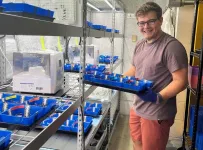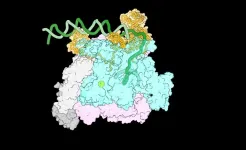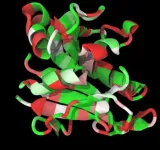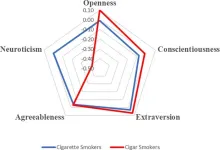(Press-News.org) URBANA, Ill. – Urban agriculture has the potential to improve food security through local, efficient, and sustainable food production. Examples of urban food systems include hydroponics, where plants grow in a nutrient solution without soil, and aquaponics, which combines hydroponics with raising fish in tanks.
A new study from the University of Illinois Urbana-Champaign examines the use of aquaponics wastewater as a growth medium for lettuce in a hydroponic system. This practice can potentially create a circular ecosystem for organic waste recycling and food production.
The researchers tested effluent from two aquaponic systems in combination with liquid residual from hydrothermal liquefaction (HTL), an emerging technology that converts wet biomass to biocrude oil through a high-temperature, high-pressure process. HTL yields a wastewater called hydrothermal liquefaction aqueous phase (HTL-AP), which is rich in nutrients and can potentially be used as fertilizer.
“We wanted to see if the naturally occurring microbes from fish waste in aquaponic systems could help convert the nutrients in HTL-AP into forms that plants can absorb. We focused on using wastewater for lettuce seed germination. Eventually, we’ll observe different stages of crop growth, including full-grown lettuce and other crops,” said lead author Liam Reynolds, a doctoral student in the Department of Agricultural and Biological Engineering (ABE), part of the College of Agricultural, Consumer and Environmental Sciences and The Grainger College of Engineering at Illinois.
Reynolds conducted the research as an undergraduate student in ABE. He won second place for the paper in the K.K. Barnes Student Paper Award Competition at the 2023 American Society for Agricultural and Biological Engineers Annual International Meeting in Omaha, NE.
For the study, Reynolds placed Buttercrunch lettuce seeds in Ziploc plastic bags on paper towels saturated with the wastewater treatments for 10 days, measuring seed germination rate and growth.
He tested 32 trial solutions combining different percentages of HTL-AP with wastewater from aquaponic systems at the U. of I.’s Bevier Café and the Chicago High School for Agricultural Sciences. The trials also included standard hydroponic fertilizer and deionized water as control solutions.
“We’ve previously shown that it’s possible to grow lettuce hydroponically using treated wastewater; however, it doesn’t grow as quickly and effectively as it could. There are likely to be some toxic compounds inhibiting plant growth, and there are also not enough nutrients in a plant-available form,” said co-author Paul Davidson, an associate professor in ABE.
In earlier studies, Davidson’s research team used 2.5% HTL-AP; however, Reynolds tested solutions ranging from 1% to 10%.
“We found that solutions containing up to 8% HTL-AP are still viable for plant growth, at least in the germination phase. This is a higher percentage of HTL-AP than anybody has demonstrated before,” Davidson stated. “This makes it possible to recycle a waste stream that would otherwise go to a wastewater treatment plant, which takes up resources, or it would be discharged into the environment causing pollution.”
While the researchers did not find evidence the fish waste microbes benefited the lettuce at the seed germination stage, they expect to see effects as the lettuce grows. For now, they concluded that a combination of HTL-AP and aquaponic wastewaters does not inhibit the germination of lettuce seeds.
Aquaponic effluents could eventually supplement or even replace standard liquid fertilizers, although more work is needed to ensure the right combination of wastewater to provide adequate nutrition for hydroponic crop production. Davidson’s team will also address food safety issues, as some sources of wastewater may contain heavy metals that are toxic to humans.
The researchers conclude it is crucial to identify alternative nutrient sources to increase the circularity of global food-production systems as well as decrease the reliance on chemical fertilizers derived from fossil fuels.
The paper, “Investigating the Impacts of Wastewaters on Lettuce (Lactuca sativa) Seed Germination and Growth,” is published in Agriculture [DOI: 10.3390/agriculture14040608]. Authors include Liam Reynolds, Vitória Leme, and Paul Davidson. This work was partially funded by the USDA National Institute of Food and Agriculture, Hatch project 1021253.
END
Wastewater is a viable medium for growing lettuce in hydroponic systems, study shows
2024-07-03
ELSE PRESS RELEASES FROM THIS DATE:
Researchers capture never-before-seen view of gene transcription
2024-07-03
Every living cell transcribes DNA into RNA. This process begins when an enzyme called RNA polymerase (RNAP) clamps onto DNA. Within a few hundred milliseconds, the DNA double helix unwinds to form a node known as the transcription bubble, so that one exposed DNA strand can be copied into a complementary RNA strand.
How RNAP accomplishes this feat is largely unknown. A snapshot of RNAP in the act of opening that bubble would provide a wealth of information, but the process happens too quickly for current technology to easily capture visualizations ...
Do genes-in-pieces code for proteins that fold in pieces?
2024-07-03
A new study led by Rice University’s Peter Wolynes offers new insights into the evolution of foldable proteins. The research was published in the Proceedings of the National Academy of Sciences.
Researchers at Rice and the University of Buenos Aires used energy landscape theory to distinguish between foldable and nonfoldable parts of protein sequences. Their study illuminates the ongoing debate about whether the pieces of DNA that code for only part of a protein during their origins can fold on their own.
The researchers focused on the extensive relationship between exons in protein structures and the evolution of protein foldability. They highlighted ...
Can inflammation in early adulthood affect memory, thinking in middle age?
2024-07-03
MINNEAPOLIS – Having higher levels of inflammation in your 20s and 30s may be linked to having memory and thinking problems at middle age, according to a study published in the July 3, 2024, online issue of Neurology®, the medical journal of the American Academy of Neurology. The study looked at levels of C-reactive protein (CRP) in the blood. CRP is produced by the liver and increases when there is inflammation in the body. The study does not prove that having higher levels of this protein causes dementia. It only shows an association.
There are two kinds of inflammation. Acute inflammation happens when the body’s immune response jumps into action to fight off infection or ...
Poor health, stress in 20s takes toll in 40s with lower cognition
2024-07-03
Higher inflammation in young adulthood linked to lower performance in skills testing in midlife.
Young adults who have higher levels of inflammation, which is associated with obesity, physical inactivity, chronic illness, stress and smoking, may experience reduced cognitive function in midlife, a new study out of UC San Francisco has found.
Researchers previously linked higher inflammation in older adults to dementia, but this is one of the first studies to connect inflammation in early adulthood with lower cognitive abilities in midlife.
“We know from long-term studies that brain changes leading to Alzheimer’s ...
Scientists may have found how to diagnose elusive neuro disorder
2024-07-03
Progressive supranuclear palsy (PSP), a mysterious and deadly neurological disorder, usually goes undiagnosed until after a patient dies and an autopsy is performed. But now, UC San Francisco researchers have found a way to identify the condition while patients are still alive.
A study appearing in Neurology on July 3 has found a pattern in the spinal fluid of PSP patients, using a new high-throughput technology that can measure thousands of proteins in a tiny drop of fluid.
Researchers ...
Cracking the code for cerebellar movement disorders
2024-07-03
The cerebellum is a region of the brain that helps us refine our movements and learn new motor skills. Patients and mouse models experience many kinds of abnormal movements when their cerebellum is damaged. They can have uncoordinated and unbalanced movements, called ataxia. They can have atypical positioning of body parts or uncontrolled movements because their muscles are working against each other, called dystonia. Or they can have disruptive shaky movements, called tremors. Understanding how changes in a single brain region ...
Stability indicating RP-HPLC method for the estimation of impurities in esomeprazole gastro-resistant tablets by AQbD approach
2024-07-03
https://www.scienceopen.com/hosted-document?doi=10.15212/bioi-2024-0018
Announcing a new article publication for BIO Integration journal. Esomeprazole (ESO) gastro-resistant tablets (40 mg) are sold under the brand name, Zosa, which effectively manages conditions associated with the overproduction of gastric acid, including peptic ulcer disease and Zollinger-Ellison syndrome. This article quantifies impurities in esomeprazole using advanced analytical techniques known as analytical quality by design with high-performance liquid chromatography.
Buffer selection ...
Clinical implications and procedural complications in patients with patent foramen ovale concomitant with atrial septal aneurysm
2024-07-03
https://www.scienceopen.com/hosted-document?doi=10.15212/CVIA.2024.0038
Announcing a new article publication for Cardiovascular Innovations and Applications journal. Atrial septal aneurysm (ASA) is defined as excursion of the atrial septum exceeding 10 mm beyond the atrial septum into the right or left atrium, or a combined total excursion of 15 mm on the right and left sides during the cardiac cycle. According to previous studies, 20–40% of patent foramen ovale (PFO) cases are accompanied by ASAs. ASA is associated with the presence of PFO, left atrial dysfunction, cryptogenic stroke, migraine, and arterial embolism, thus making ...
Cryptocurrency investors are more likely to self-report “Dark Tetrad” personality traits alongside other characteristics
2024-07-03
Owning cryptocurrency may be associated with certain personality and demographic characteristics as well as a reliance on alternative or fringe social media sources, according to a study published July 3, 2024 in the open-access journal PLOS ONE by Shane Littrell from the University of Toronto, Canada, along with colleagues from the University of Miami, USA.
Anonymous trading and unregulated markets hallmark cryptocurrency’s unique subculture. While some consider the digital currency to be financially unreliable, hundreds of millions of global investors think otherwise.
This study identified various political, psychological, and social characteristics ...
Smoking behavior is linked to personality traits
2024-07-03
Cigarette smokers, cigar smokers, and non-smokers each have distinct personality profiles, according to a study published July 3, 2024 in the open-access journal PLOS ONE by Dritjon Gruda from Universidade Catolica Portuguesa, Portugal, and Jim McCleskey from Western Governors University, USA.
Tobacco use remains a formidable global public health challenge, responsible for more than 8 million deaths annually, including those attributed to second-hand smoke exposure. Emerging research underscores the critical role of psychological factors, including personality traits, in shaping ...




